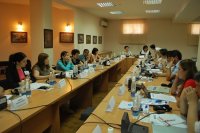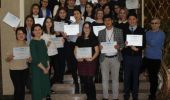 The participants agreed the idea of diversity and multilinguism
should be supported and widely promoted to make representatives of all ethnic
groups living in Kyrgyzstan feel themselves comfortable and equal. However, media
attempts are not sufficient. A package of measures is required at the level of
state policy.
The participants agreed the idea of diversity and multilinguism
should be supported and widely promoted to make representatives of all ethnic
groups living in Kyrgyzstan feel themselves comfortable and equal. However, media
attempts are not sufficient. A package of measures is required at the level of
state policy.
 According to the recent media monitoring report "Cyberhate as a trend of modern media wars”,
were demonstrated at the Almaty Forum (Kazakhstan) on April 29-30.
According to the recent media monitoring report "Cyberhate as a trend of modern media wars”,
were demonstrated at the Almaty Forum (Kazakhstan) on April 29-30.
According to the School’s analytical group assessment, the number of hostile attacks has increased on the network almost by one fourth. The research of Kyrgyzstan online media has shown that 56% of articles and posts monitored contain hostile comments and provocative calls.
"Until now, media monitoring for hate speech on the web have been perceived in terms of ethnic stereotypes, xenophobia and racism,” Inga Sikorskaya, Director of School of Peacemaking and Media Technologies, said during the presentation. "Now cyber attacks are the major part of hate speech content against various groups expressed in diverse forms.”
 The analytical report shows that the number of hostile attacks in the network has increased by one fourth. Monitoring of Kyrgyz online content has shown that 56% of all articles and posts in social networks contain hostile comments and provocative calls.
The analytical report shows that the number of hostile attacks in the network has increased by one fourth. Monitoring of Kyrgyz online content has shown that 56% of all articles and posts in social networks contain hostile comments and provocative calls.
___Kibervrazhda-trend-sovremennyh-media-voyn.pdf The research data have been demonstrated at the presentation delivered at the 5th annual forum "Development of Web Sphere in Central Asia InternetCA-2014”.
For additional info please contact us at: ca-mediator@safe-mail.net

The School of Peacemaking and Media Technology in Central Asia announces an annual competition among students from Kyrgyzstan, Kazakhstan,…

25 journalists and media workers from various regions of Kyrgyzstan have been trained to counter the propaganda of violent extremism and hate in…